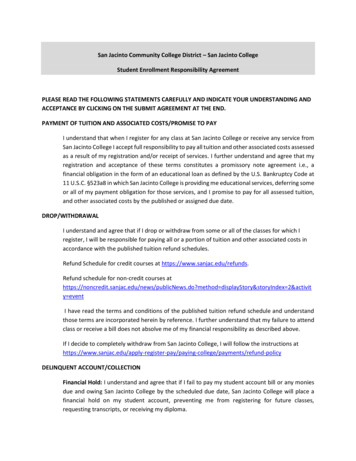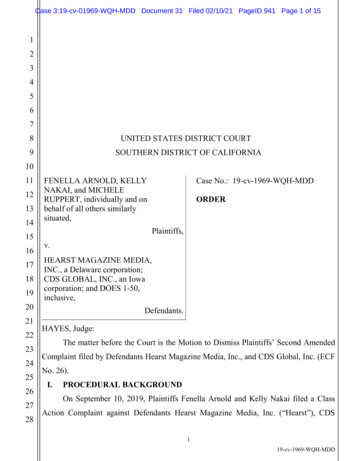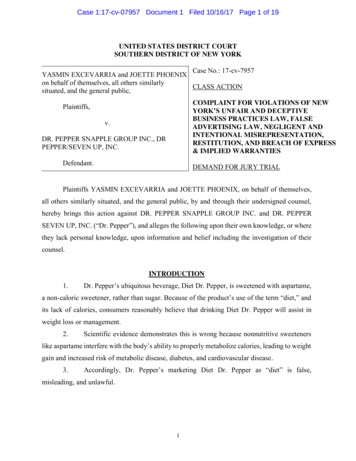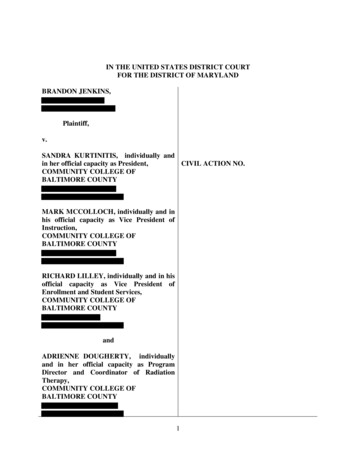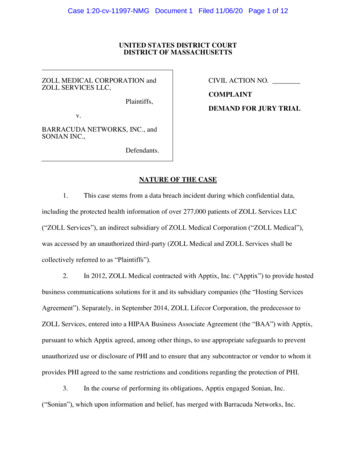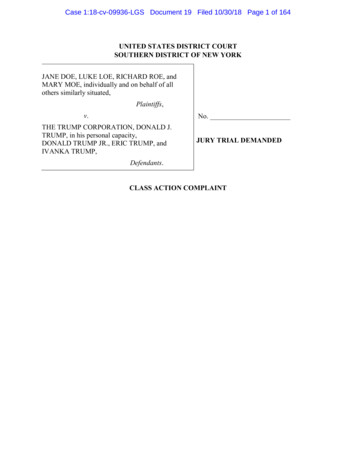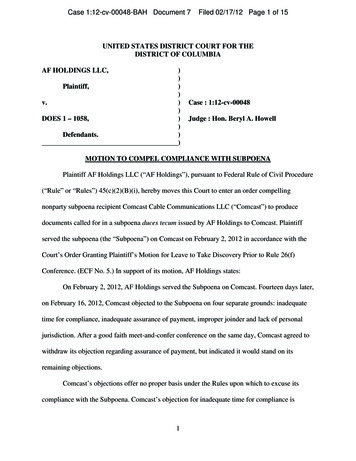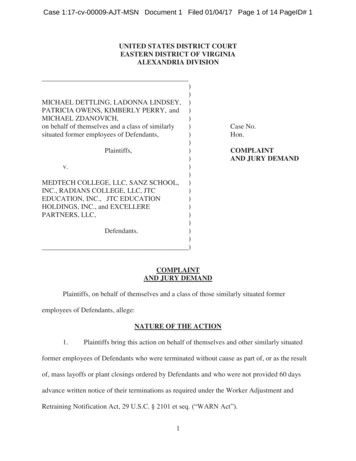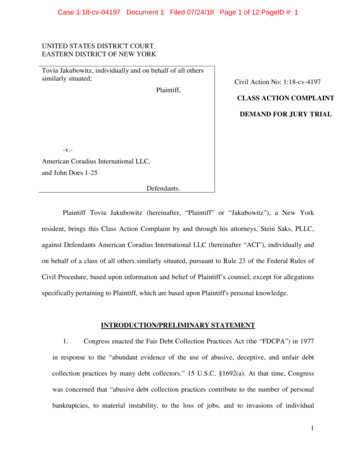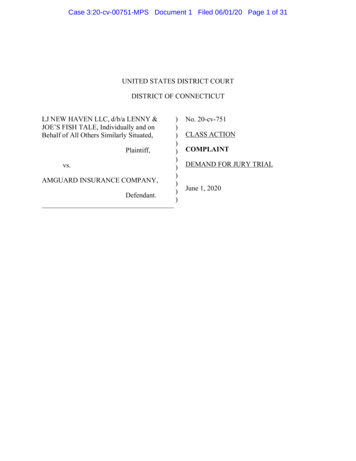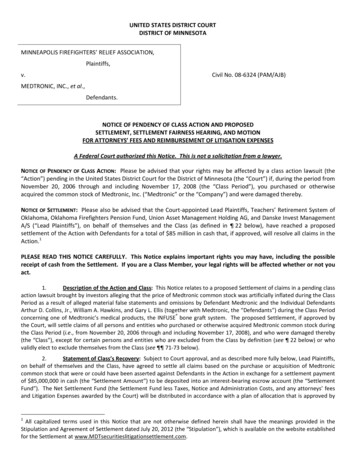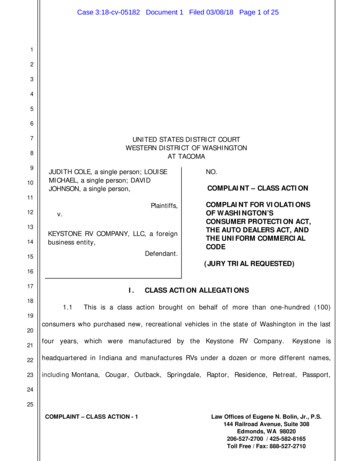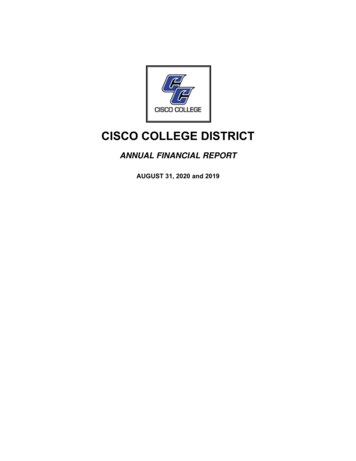
Transcription
CISCO COLLEGE DISTRICTANNUAL FINANCIAL REPORTAUGUST 31, 2020 and 2019
CISCO COLLEGE DISTRICTANNUAL FINANCIAL REPORTFOR THE YEARS ENDED AUGUST 31, 2020 AND 2019TABLE OF CONTENTSPageNames and Terms of the Board of Regents, Principal Administrative Officers, andthe Business and Financial Staff1FINANCIAL SECTIONIndependent Auditors’ ReportManagement’s Discussion and Analysis (Required Supplementary Information)Statements of Net PositionStatements of Revenues, Expenses and Changes in Net PositionStatements of Cash FlowsNotes to the Financial Statements2-34-7891011-33Exhibit123REQUIRED SUPPLEMENTARY INFORMATIONSchedule of District’s Proportionate Share of the Net Pension LiabilitySchedule of District Contributions for PensionsSchedule of District’s Proportionate Share of the Net OPEB LiabilitySchedule of District Contributions for OPEB343536374567SUPPLEMENTAL SCHEDULESSchedule of Operating RevenuesSchedule of Operating Expenses by ObjectSchedule of Non-Operating Revenues and ExpensesSchedule of Net Position by Source and AvailabilitySchedule of Expenditures of Federal AwardsSchedule of Expenditures of State Awards383940414243ABCDEFOVERALL COMPLIANCE AND INTERNAL CONTROL SECTIONIndependent Auditors’ Report on Internal Control Over Financial Reporting and onCompliance and Other Matters Based on an Audit of Financial StatementsPerformed in Accordance with Government Auditing Standards44-45FEDERAL AWARDS SECTIONIndependent Auditors’ Report on Compliance For Each Major Federal Program andon Internal Control Over Compliance Required by the Uniform GuidanceSchedule of Findings and Questioned CostsSummary Schedule of Prior Audit FindingsCorrective Action Plan46-4748-505152
CISCO COLLEGE DISTRICTORGANIZATIONAL DATAFOR THE FISCAL YEAR 2019-20Board of RegentsOfficersBrad KimbroughRonnie LedbetterRicky WhatleyPresidentVice-PresidentSecretaryMembersTerm ExpiresMay 31,Jerry ConringJoe JarvisMatt JohnsonBrad KimbroughRonnie LedbetterRick WattsRicky WhatleySharon WilcoxenStaci WilksCisco, TexasCisco, TexasCisco, TexasCisco, TexasCisco, TexasCisco, TexasCisco, TexasCisco, TexasCisco, TexasKey OfficersDr. Thad Anglin – PresidentDr. Jerry Dodson – Vice President for Student ServicesDr. Carol Dupree – Provost, Abilene Educational Center and Chief Academic OfficerAudra Taylor – Dean of Business Services and Chief Financial Officer1202020242024202220242026202020222022
Financial Section
993 North Third StreetPO Box 2993Abilene, Texas 79604-2993Phone 325-677-6251Fax 325-677-0006www.condley.comCertified Public Accountants and Business AdvisorsDecember 14, 2020To the Board of RegentsCisco College DistrictCisco, TexasINDEPENDENT AUDITORS’ REPORTReport on the Financial StatementsWe have audited the accompanying financial statements of the business-type activities of Cisco CollegeDistrict (the “District”) which includes the statements of net position as of August 31, 2020 and 2019, andthe related statements of revenues, expenses and changes in net position and cash flows for the yearsended August 31, 2020 and 2019, and the related notes to the financial statements, which collectivelycomprise the District’s basic financial statements as listed in the table of contents.Management’s Responsibility for the Financial StatementsManagement is responsible for the preparation and fair presentation of these financial statements inaccordance with accounting principles generally accepted in the United States of America; this includes thedesign, implementation, and maintenance of internal control relevant to the preparation and fairpresentation of financial statements that are free from material misstatement, whether due to fraud or error.Auditors’ ResponsibilityOur responsibility is to express an opinion on these financial statements based on our audits. Weconducted our audits in accordance with auditing standards generally accepted in the United States ofAmerica and the standards applicable to financial audits contained in Government Auditing Standards,issued by the Comptroller General of the United States. Those standards require that we plan and performthe audits to obtain reasonable assurance about whether the general-purpose financial statements are freeof material misstatement.An audit involves performing procedures to obtain audit evidence about the amounts and disclosures in thefinancial statements. The procedures selected depend on the auditor’s judgment, including the assessmentof the risks of material misstatement of the financial statements, whether due to fraud or error. In makingthose risk assessments, the auditor considers internal control relevant to the entity’s preparation and fairpresentation of the financial statements in order to design audit procedures that are appropriate in thecircumstances, but not for the purpose of expressing an opinion on the effectiveness of the entity’s internalcontrol. Accordingly, we express no such opinion. An audit also includes evaluating the appropriatenessof accounting policies used and the reasonableness of significant accounting estimates made bymanagement, as well as evaluating the overall presentation of the financial statements.We believe that the audit evidence we have obtained is sufficient and appropriate to provide a basis for ouraudit opinion.OpinionIn our opinion, the financial statements referred to above present fairly, in all material respects, therespective financial position of the business-type activities of Cisco College District as of August 31, 2020and 2019, and the respective changes in financial position, and cash flows for the years then ended inaccordance with accounting principles generally accepted in the United States of America.2
Other MattersRequired Supplementary InformationAccounting principles generally accepted in the United States of America require that Management’sDiscussion and Analysis on pages 4-7, Schedule of District’s Proportionate Share of the Net PensionLiability, Schedule of District’s Contributions for Pensions on pages 34-35, Schedule of District’sProportionate Share of Net OPEB Liability and Schedule of District’s Contributions for OPEB on pages36-37 be presented to supplement the basic financial statements. Such information, although not a part ofthe basic financial statements, is required by the Governmental Accounting Standards Board who considersit to be an essential part of financial reporting for placing the basic financial statements in an appropriateoperational, economic, or historical context. We have applied certain limited procedures to the requiredsupplementary information in accordance with auditing standards generally accepted in the United Statesof America, which consisted of inquiries of management about the methods of preparing the informationand comparing the information for consistency with management’s responses to our inquiries, the basicfinancial statements, and other knowledge we obtained during our audit of the basic financial statements.We do not express an opinion or provide any assurance on the information because the limited proceduresdo not provide us with sufficient evidence to express an opinion or provide any assurance.Other InformationOur audit was conducted for the purpose of forming opinions on the financial statements that collectivelycomprise the District’s basic financial statements. The supporting schedules (Schedules A-F), includingthe schedule of expenditures of federal awards as required by Title 2 U.S. Code of Federal Regulations(CFR) Part 200, Uniform Administrative Requirements, Cost Principles, and Audit Requirements for FederalAwards, and the introductory section are presented for the purposes of additional analysis and are not arequired part of the basic financial statements.The supporting schedules are the responsibility of management and were derived from and relate directlyto the underlying accounting and other records used to prepare the basic financial statements. Suchinformation has been subjected to the auditing procedures applied in the audit of the basic financialstatements and certain additional procedures, including comparing and reconciling such information directlyto the underlying accounting and other records used to prepare the basic financial statements or to thebasic financial statements themselves, and other additional procedures in accordance with auditingstandards generally accepted in the United States of America. In our opinion, the supporting schedules,which includes the schedule of expenditures of federal awards, are fairly stated in all material respects inrelation to the basic financial statements as a whole.The introductory section has not been subjected to the auditing procedures applied in the audit of the basicfinancial statements and, accordingly, we do not express an opinion or provide any assurance on it.Other Reporting Required by Government Auditing StandardsIn accordance with Government Auditing Standards, we have also issued our report dated December 14,2020, on our consideration of the District’s internal control over financial reporting and on our tests of itscompliance with certain provisions of laws, regulations, contracts, and grant agreements and other matters.The purpose of that report is to describe the scope of our testing of internal control over financial reportingand compliance and the results of that testing, and not to provide an opinion on internal control over financialreporting or on compliance. That report is an integral part of an audit performed in accordance withGovernment Auditing Standards in considering the District’s internal control over financial reporting andcompliance.Certified Public Accountants3
Management’s Discussion and AnalysisRequired Supplementary Information
Cisco College DistrictMANAGEMENT’S DISCUSSION AND ANALYSISAugust 31, 2020The following discussion of Cisco College District’s (the “District”) financial reports presents our analysisand insight to the Disrict’s financial performance for the fiscal year ended August 31, 2020, including somecomparative information with the fiscal years ended August 31, 2019 and 2018. Please read it inconjunction with the transmittal letter preceding this report and the District’s financial statements, whichfollow this report.The Basic Financial StatementsThe annual financial report consists of a set of financial statements and reports as required by GovernmentAccounting Standards Board (GASB) Statement No. 34 for a government engaged in business-typeactivities. These basic financial statements appear in Exhibits 1-3 and in the notes to the financialstatements. The basic financial statements consist of the following four elements: a Statement of NetPosition; a Statement of Revenues, Expenses, and Changes in Net Position; a Statement of Cash Flows;and the Notes to the Financial Statements. These statements are presented in a government-wide format,which means all of the funds of the District are combined into a single report. A brief explanation of thepurpose of each of the components of the basic financial statements is set out below.The Statement of Net Position shows the combined assets of the District, as well as the combined liabilities.The difference in the total assets and the total liabilities is the net position, which are broken out in itsvarious components. The information shown in this statement is a snapshot of the District’s accounts onAugust 31 of the year indicated. This is important data in determining the viability of the school and indetermining the District’s overall financial strength.The Statement of Revenues, Expenses, and Changes in Net Position shows the results of the fiscal year’soperations. Revenues and expenses are arranged by their functional classifications so that a year-to-yearcomparison will show relevant trends. The information in this statement will assist in evaluating the District’sperformance for the year concluded.The Statement of Cash Flows shows the sources and uses of cash for the fiscal year. It is divided intoseveral categories: operating activities, non-capital financing activities, capital financing activities, andinvesting activities. Upon review of the cash flow statement, a person knowledgeable in using thisstatement can determine an institution’s ability to generate future cash flows, and its ability to meet financialobligations.The Notes to the Financial Statements provide the required disclosures to comply with GASBpronouncements and other relevant information that a user might find helpful in understanding the District’sfinancial statements as a whole.4
Condensed Comparative Financial InformationTable 1- Net PositionYear EndedAugust 31,2020Current and Other AssetsCapital AssetsDeferred Resource OutflowsTotal Assets and Deferred Resource OutflowsCurrent LiabilitiesLong-term LiabilitiesDeferred Resource InflowsTotal Liabilities and Deferred Resource InflowsNet Position:Net Investment in Capital AssetsRestrictedUnrestricted and ExpendableTotal Net Position5Year EndedAugust 31,2019Year EndedAugust 31,2018 6,856,726 14,781,800 4,448,615 5,677,971 15,151,694 4,281,144 7,289,293 15,249,063 746,358 26,087,141 25,110,809 23,284,714 3,083,043 21,002,373 5,666,616 2,618,643 21,304,901 5,586,692 4,131,620 20,277,799 3,359,042 29,752,032 29,510,236 27,768,461 10,196,800 1,634,976( 15,496,667) 9,881,694 1,603,912( 15,885,033) 9,297,465 687,487( 14,468,699)( 3,664,891)( 4,399,427)( 4,483,747)
Table 2 - Changes in Net PositionYear EndedAugust 31,2020Operating Revenue:Tuition and Fees, Net of DiscountsFederal Grants and ContractsAuxiliary Enterprises, Net of DiscountsOther Operating RevenuesTotal Operating RevenuesOperating Expenses:InstructionPublic ServiceAcademic SupportStudent ServicesInstitutional SupportOperation and Maintenance of PlantScholarships and FellowshipsAuxiliary EnterprisesDepreciationTotal Operating ExpensesOperating LossNon-operating Revenue (Expenses):State AppropriationsMaintenance Ad valorem TaxesFederal RevenueInterest on Capital Related DebtOther Non-operating Revenue (Expense)Net Non-operating RevenueIncrease in Net PositionNet Position – Beginning of YearAdjustmentsYear EndedAugust 31,2019 5,284,395 286,814 1,106,258 515,129 4,929,103 270,524 1,689,615 584,810 4,600,209 227,455 2,006,043 863,270 7,192,596 7,474,052 7,696,977 7,995,615 6,567 782,060 1,614,583 4,651,603 1,743,446 5,059,111 1,638,573 683,082 7,870,248 2,069 953,108 1,688,847 2,735,747 1,594,802 5,551,543 2,899,454 665,176 8,233,462 1,730 785,810 1,793,002 3,010,248 1,609,318 5,315,385 2,935,301 694,083 24,174,640 23,960,994 24,378,339( 16,682,044)( 16,486,942)( 16,681,362) 7,012,611 1,217,358 9,426,151( 175,776) 236,236 6,360,709 1,174,942 9,000,600( 194,655) 229,666 7,254,024 917,097 8,941,574( 209,888) 289,566 17,716,580 16,571,262 17,192,373 734,536( 4,399,427) 84,320( 4,483,747) 511,011 9,442,775-Net Position – End of YearYear EndedAugust 31,2018( 3,664,891)( 4,399,427)( 14,437,533)( 4,483,747)Analysis of the District’s Overall Financial Position and Results of OperationsTables 1 and 2 provide summarization of significant financial data from the Statements of Net Position andinformation concerning the District’s results of operations for the past three years. Current and Other Assetsincreased because of cash and cash equivalents, deposits, and accounts receivable. Student tuition andfees remained a major source of revenue for 2020. Net tuition and fees increased by 355,292 from 2019to 2020. Auxiliary revenue decreased by 583,357 from 2019 to 2020 due to the outsourcing of thebookstore and the early closure of the cafeteria in the Spring 2020 due to COVID 19; however, it also6
affected the auxiliary expense which decreased by 1,260,881. Maintenance ad valorem tax revenueincreased by 42,416 from 2019 to 2020 due to keeping the tax rate at .2000 per 100 valuation.Significant Capital Assets and Long-Term Debt ActivityNote 5 to the financial statements is a summary of the current fiscal year’s capital asset activity. A reviewof this data shows net additions to capital assets of 140,952. These were offset by depreciation expenseof 683,083. Changes to capital assets during the year include furniture, machinery, vehicles and otherequipment of 103,211 and an increase to buildings of 37,741. There is also an increase of 83,164 toconstruction in progress.Note 6 to the financial statements is a composite of the District’s long-term liabilities for the current andprevious fiscal years. There was a reduction to the Revenue Bonds and Notes for payments made duringthe year. There were also decreases to the Net Pension Liability and increases to the Net OPEB Liabilitydue to GASB Statement No. 68 and GASB Statement No. 75.Discussion of Other Facts, Decisions, and ConditionsCOVID 19 brought unexpected challenges to the operations of the District beginning in March of 2020.These challenges required immediate changes in the District’s overall operations. The most significant wastransitioning the District’s face-to-face classes to an online delivery format and resolving issues connectedto career and technical programs that require hands on experimental learning. These changes requiredadditional expenditures in Information Technology for technical equipment and infrastructure support forstudents, faculty, and staff. In Maintenance and Operations, the District moved quickly to secure/purchasecleaning supplies, personal protective equipment, and install sneeze/cough guards on all front deskoperations on the Abilene and Cisco campuses.While operating costs associated with the COVID 19 pandemic increased, a portion of the increase wasoffset by Federal CARES Act funding. The most significant impact of the COVID 19 pandemic continuesto be on tuition and fee revenue due to declining enrollments starting in the summer of 2020.The District’s executive team is preparing for further declines in enrollment for FY 2021. While the revenueis expected to be down, expenditures will follow as a result of the decline in the need for faculty courseoverloads, adjunct faculty, and travel associated with the delivery of dual credit courses and professionaldevelopment.The return to manageable enrollment growth will largely depend on the production, distribution, and deliveryof a COVID 19 vaccination. The District’s Executive Council and Strategic Planning Committee is preparingfor future growth as the economy resets and the need for skilled workers in critical health care and industrialsectors returns to above pandemic levels.The District remains strong and in good strategic position to grow student enrollment and expandinfrastructure and capital improvements. Partnerships with local and regional four-year universities,business and industry leaders, and over thirty high schools across the region will most certainly continueto grow as economic factors improve. It is these partnerships that will ultimately lead the District towardpassing a 0.05 maintenance tax for the Abilene Education Center, which will lead to the enhancement ofexisting programs, and the addition of others.Contacting Cisco College District’s Financial ManagementThis financial report is designed to provide our citizens, taxpayers, customers, and creditors with a generaloverview of the District’s finances and to show the District’s accountability for the money it receives. If youhave any questions about this report or need additional financial information, contact the Chief FinancialOfficer: Cisco College District, 101 College Heights, Cisco, Texas 76437.7
Basic Financial Statements
CISCO COLLEGE DISTRICTSTATEMENTS OF NET POSITIONAUGUST 31, 2020 AND 2019EXHIBIT 12020ASSETSCurrent Assets:Cash and cash equivalentsAccounts receivable (net)Deferred chargesInventoriesDepositPrepaid expensesTotal Current Assets Noncurrent Assets:Restricted cash and cash equivalentsRestricted cash and cash equivalents - endowmentsLong-term investments - restricted for endowmentsLong-term investments - otherInve
operational, economic, or historical context. We have applied certain limited procedures to the required . The following discussion of Cisco College District’s (the “District”) financial reports presents our analysis and insight to the Disrict’s financial performance for
